- Joined
- Nov 16, 2012
- Messages
- 5,596
All,
Thought I'd post this in case someone finds it useful... It's a way to adjust your compound depth to take off a desired amount from either the face or side of a piece. This can also be used to check how accurate the compound angles are scribed on your machine. This works with any angle setting.
Lets say you want to take a face cut of 0.005" and your compound angle happens to be set to 30 degrees and you don't wish to change it. Question is, how much should you turn the compound depth to make that cut? Here's how:
First touch the face:
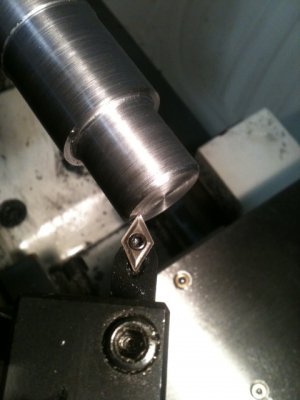
Next, reset the compound ring to zero (but don't change the bit position). On this lathe, the depth rings can be reset like this but if your lathe doesn't do this, just keep track of the number it's set to.
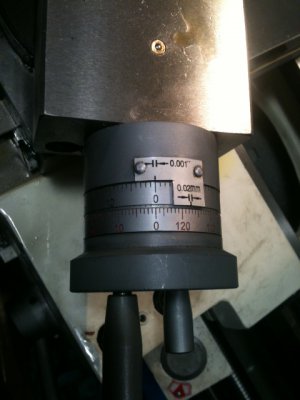
Now use this formula. I'm going to abbreviate Sine as Sin. These are mathematical functions found on most calculators.
Adjustment = DesiredFaceCutDepth / Sin (Angle).
In this case, that is 0.005/Sin(30). On a calculator, this equals 0.010. Which means the compound knob must be turned in 10 thou.
This will work for any angle but you need to recalculate the formula. Let's say you still wanted to take a face cut of 0.005" but your angle was set to 22 degrees. Now, you would do this: 0.005/Sin(22) which equals 0.0133. In this case, I would set the compound dial to just a baby's breath over 13 thou to take 5 thou off the face if the compound angle was set to 22 degrees.
If you don't believe this works, you can check with a feeler gauge like this -and by the way, this is a good way to see if the scribe marks on your compound angle are accurate. BTW, my compound is off by 1 degree and I've proven it "mathematically" with this technique and I've cut metal and measured it to double-check.
In this example, set your compound to read 30 degrees. Just like before, touch-off the face and reset the dial to zero (or keep track of the number). Please note, I'm setting my compound to 31 degrees because I know it's off by 1. To test yours, set it to 30.


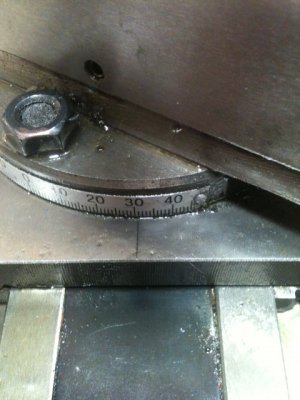
Next, backout the compound dial 10 thou. Make sure you've accounted for backlash in the leadscrew. To do this, back out way more than 10 thou until the compound is actually moving then, slowly approach the value you want without backing-up again.
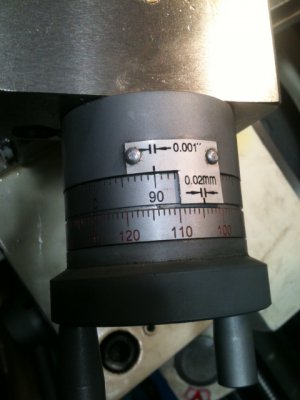
Now take a 0.005" feeler gauge blade and check the gap distance.
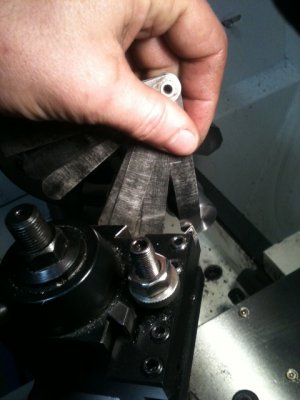
Feeler gauges are indeed "touchy" things... Everybody seems to have a different feel for how they use them but, you get the picture here. If you're not getting somewhere darn close to 0.005", it means your compound angle is not scribed accurately.
And by the way, you can do exactly the same thing for side cuts (not face cuts) by using the Cosine (also called Cos) function. The formula is the same, just use Cos.
Here's a side cut and let's assume that for some reason, I don't want to use the crossfeed to adjust the depth and I want to use the compound dial. These situations arise from time to time...
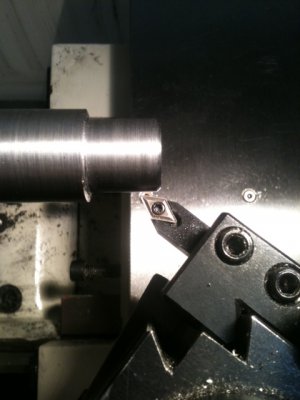
Adjustment = DesiredSideCutDepth / Cos (angle). In this case, my angle is still 30 degrees and I desire to make a 0.005" DOC. This is:
0.005/cos(30) which equals 0.0058" meaning I'd need to crank the compound dial in almost 6 thou to make a 5 thou cut if the compound angle was at 30 degrees.
If anyone is having troubles with the sines and cosines on their calculators, shout it out and we can go over it. And if you don't have a calculator with this, you can use the trig tables found in the machinists handbook or similar books.
BTW: That's a pilot shaft I'm making from the ground up in the pictures and since I don't have DRO, the only way I can get that end piece the right length is by using this technique... So it is practical to know.
Ray






Thought I'd post this in case someone finds it useful... It's a way to adjust your compound depth to take off a desired amount from either the face or side of a piece. This can also be used to check how accurate the compound angles are scribed on your machine. This works with any angle setting.
Lets say you want to take a face cut of 0.005" and your compound angle happens to be set to 30 degrees and you don't wish to change it. Question is, how much should you turn the compound depth to make that cut? Here's how:
First touch the face:

Next, reset the compound ring to zero (but don't change the bit position). On this lathe, the depth rings can be reset like this but if your lathe doesn't do this, just keep track of the number it's set to.

Now use this formula. I'm going to abbreviate Sine as Sin. These are mathematical functions found on most calculators.
Adjustment = DesiredFaceCutDepth / Sin (Angle).
In this case, that is 0.005/Sin(30). On a calculator, this equals 0.010. Which means the compound knob must be turned in 10 thou.
This will work for any angle but you need to recalculate the formula. Let's say you still wanted to take a face cut of 0.005" but your angle was set to 22 degrees. Now, you would do this: 0.005/Sin(22) which equals 0.0133. In this case, I would set the compound dial to just a baby's breath over 13 thou to take 5 thou off the face if the compound angle was set to 22 degrees.
If you don't believe this works, you can check with a feeler gauge like this -and by the way, this is a good way to see if the scribe marks on your compound angle are accurate. BTW, my compound is off by 1 degree and I've proven it "mathematically" with this technique and I've cut metal and measured it to double-check.
In this example, set your compound to read 30 degrees. Just like before, touch-off the face and reset the dial to zero (or keep track of the number). Please note, I'm setting my compound to 31 degrees because I know it's off by 1. To test yours, set it to 30.



Next, backout the compound dial 10 thou. Make sure you've accounted for backlash in the leadscrew. To do this, back out way more than 10 thou until the compound is actually moving then, slowly approach the value you want without backing-up again.

Now take a 0.005" feeler gauge blade and check the gap distance.

Feeler gauges are indeed "touchy" things... Everybody seems to have a different feel for how they use them but, you get the picture here. If you're not getting somewhere darn close to 0.005", it means your compound angle is not scribed accurately.
And by the way, you can do exactly the same thing for side cuts (not face cuts) by using the Cosine (also called Cos) function. The formula is the same, just use Cos.
Here's a side cut and let's assume that for some reason, I don't want to use the crossfeed to adjust the depth and I want to use the compound dial. These situations arise from time to time...

Adjustment = DesiredSideCutDepth / Cos (angle). In this case, my angle is still 30 degrees and I desire to make a 0.005" DOC. This is:
0.005/cos(30) which equals 0.0058" meaning I'd need to crank the compound dial in almost 6 thou to make a 5 thou cut if the compound angle was at 30 degrees.
If anyone is having troubles with the sines and cosines on their calculators, shout it out and we can go over it. And if you don't have a calculator with this, you can use the trig tables found in the machinists handbook or similar books.
BTW: That's a pilot shaft I'm making from the ground up in the pictures and since I don't have DRO, the only way I can get that end piece the right length is by using this technique... So it is practical to know.
Ray







